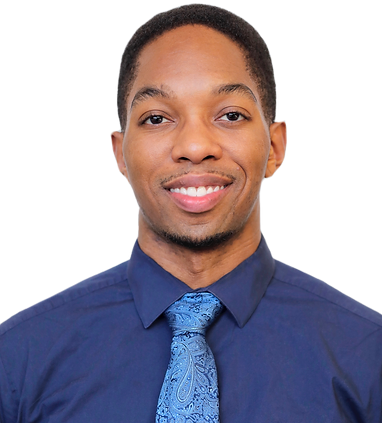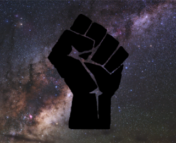February is Black History Month in the United States. For this month and beyond, we wish to continue highlighting the important work and achievements of Black astronomers, physicists, educators, and scientists through our #BlackInAstro series. This is an ongoing, year-round series in collaboration with blackinastro.com (@BlackInAstro on Twitter). For our cornerstone post, see here.

“Growing up, I was interested in [science], but I wasn’t necessarily set out to become a scientist. Where I grew up, most people will play sports or desire to become professional athletes or entertainers, if they make it out, so I wasn’t really thinking about being a scientist. It kind of happened by following a passion and then having ambition to continue on with that passion and improving those skills along the way, [until I] eventually grew into what we call a scientist.” Dr. Chris Moore’s academic journey is one of perseverance, dedication, and an undying commitment to finding success doing the science that he loved in physics and astronomy. Indeed, he is now a research associate at the Harvard-Smithsonian Center for Astrophysics (CfA) and manages a research group, leading a plethora of projects related to deepening our understanding of the solar corona.
Moore’s journey began in the Chicagoland area, where opportunities to observe the sky were few and far between. Despite that, he recalls peering out the windows of his car on road trips out of the city and marveling at the newly uncovered stellar tapestry that stretched before him. Though he did not realize it then, from these fleeting moments, a curiosity about the universe was born. When he graduated high school and entered the University of Iowa, Moore chose to study physics and astronomy almost on a whim—inspired by those childhood memories, he was curious to understand how and why the universe appears as it does. However, his adjustment to undergraduate life was not an easy one.
In the early months of his first year, Moore recalls having difficulty adjusting to the mode of thinking required for physics and complex math classes from his high school courses. Compounding that, he was one of the few (if not the only) people of color in his classes and could tell that as “a newbie coming in, there was going to be unease.” From professors acting surprised when they realized that he was a physics student and not a lost football player, to other students refusing to work with him (and some even going as far as trying to sabotage his classwork), he faced no shortage of challenges. As he describes, contending with this “was analogous to navigating the complexities of race or race relations in America, and trying to be successful in academia. There’s a new culture. There is a standard set. There’s protocols and principles in place. There’s a dominant group of people who’ve been ‘successful’ at it for a long time.”
Luckily, he did not have to struggle with this isolating experience forever. In his sophomore year, he befriended a new international student, named Barry—who he had met playing basketball—and formed a study group. This serendipitous friendship ended up helping with both of his challenges at once: from Barry, he learned new study techniques and began critically thinking about material in his classes and textbooks, and finally had a group with whom he could succeed.
During these years, he also had the opportunity to participate in an REU at the University of Colorado Laboratory for Atmospheric and Space Physics (LASP). He credits this experience with inspiring much of his later work, as he was able to see the material from his classes “implemented and executed on the satellites (because they had live missions that they were building, testing, and launching), [meet] people who assembled instruments and put them on rockets, balloons, and satellites, and work with actual scientific data coming down from those satellites.” In turn, this experience motivated him to dedicate himself more deeply to his coursework and opened his eyes to the possibility of a career in academia. Encouraged by his REU advisor, he applied to graduate school and chose to complete his Ph.D. at the University of Colorado, Boulder.
At this point, he had discovered some of his science interests that he has carried with him through his work today: he studies the interactions of light near the surfaces of stars, especially the Sun. Working on the RHESSI satellite (which leveraged the power of Fourier transforms for its measurements), he was introduced to the beauty of instrumentation and learned that imaging was not simply limited to pointing a telescope and camera at a source and counting the photons. Through a series of internships at NASA’s Goddard Space Flight Center and Jet Propulsion Laboratory (which came through the NASA Space Technology Research Fellowship), he was able to dive into these interests, getting his hands dirty working on a variety of microfabrication engineering projects. Back at Boulder, he tackled a slew of projects, from tackling numerical hydrodynamic simulations of magneto-convection in the solar photosphere (read: modeling magnetic field-driven flows on the ‘surface’ of the Sun) to designing detectors for the MinXSS CubeSat. These projects carried him through the end of his Ph.D. and into his post-doctoral position at Harvard’s CfA.
As a postdoc and now research scientist, Moore has settled into observing “the X-ray and UV light from the Sun to better constrain the heating [of the corona], [by] developing instrumentation, detectors, mirrors, and higher-quality telescopes.” He has won a variety of grants and awards related to this work and now manages a team of students—ranging from the undergraduate through graduate level—full time engineers, and post-doctoral scientists, working on these projects. In particular, he’s working on developing new X-ray optics technology which will be useful for a variety of applications, one of which is the Swift Solar Activity X-ray Imager (SSAXI-Rocket) that will be launched on a rocket in the next year!
Reflecting on his journey, he offered a few key pieces of advice:
- “Don’t be afraid to build the community that you want to see.” He recalled how manifesting community was instrumental to his development as a scientist and cited his leadership in a group known as CU CAFE (Cultural Awareness for Everyone) as an example of this effort. He and a group of other STEM graduate students of color at Boulder met with the Vice Chancellor of Diversity and secured funding to invite new colloquium speakers of a variety of identities, “bringing a different perspective on who can do science at a high level”.
- “Think about what you want to get out of graduate school.” While he found graduate school an intellectually stimulating and career-building experience, thinking back on the experiences of his peers, he noted that it may not be necessary for everyone. He emphasized the importance of identifying your goals before choosing what to do post-undergrad and deciding whether graduate school is the right step to that end.
- “Take advantage of opportunities to do professional development programs (PDPs).” He cited the Institute for Scientists and Engineering Educators (ISEE) PDP at UC Santa Cruz with helping him learn how people think about scientific concepts and credits that with giving him an edge in his grant applications and encourages aspiring scientists to do the same.
Dr. Moore has clearly established himself as a prolific scientist in the field of solar physics instrumentation and observation. He has done this while simultaneously building a community that he can be proud of from within the field and I have no doubt that he will continue to do so moving forward in his career.
To learn more about Dr. Moore, check out his website!
Astrobite edited by Evan Lewis
Featured image credit: Astrobites collaboration

